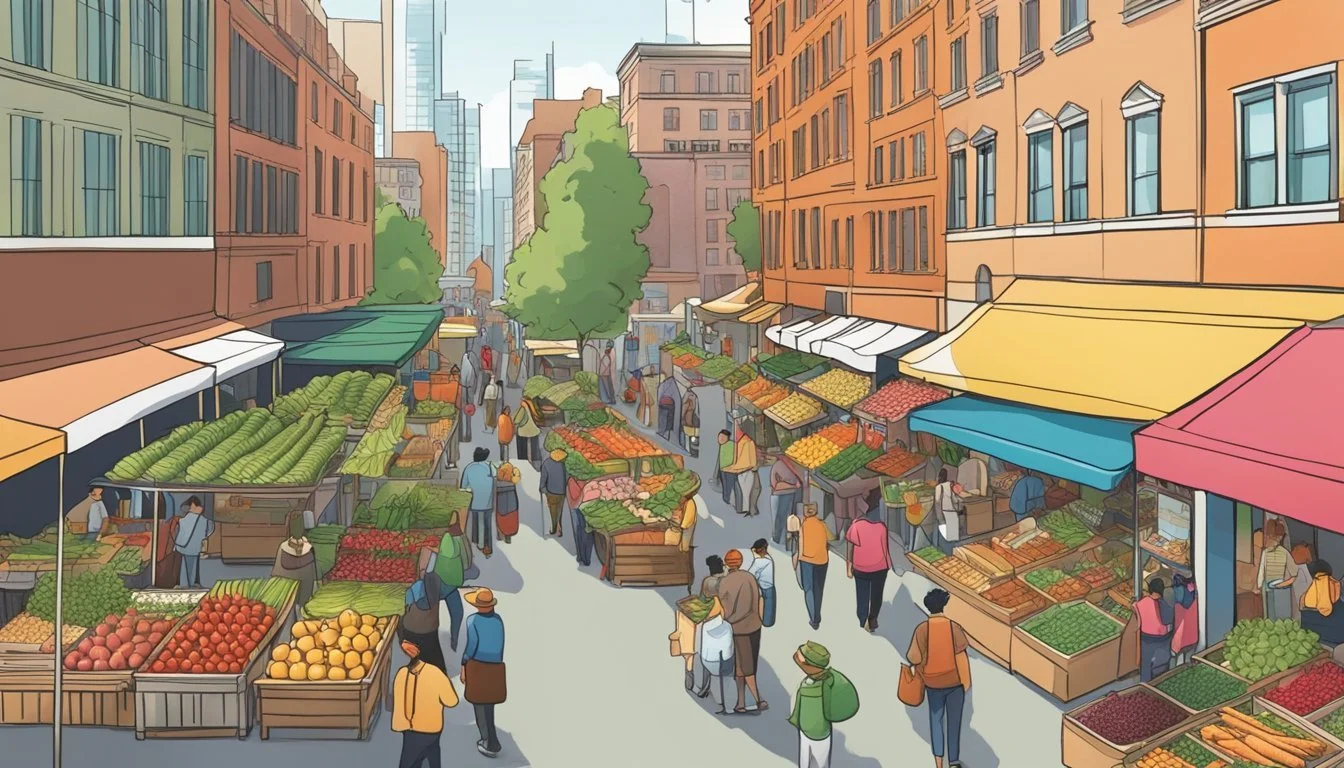The Role of Farmers' Markets in Alleviating Urban Food Deserts
Urban food deserts are geographical areas where residents have limited access to affordable and nutritious food, particularly fresh fruits and vegetables. Typically, these regions are characterized by an absence of supermarkets or grocery stores within convenient traveling distance, posing significant challenges for urban populations that seek healthy food options. Food deserts are often correlated with socioeconomic factors such as income levels, rates of car ownership, and access to public transportation, which together contribute to this discrepancy in food availability.
Farmers' markets have been increasingly recognized for their potential to mitigate the effects of urban food deserts. By providing a space where local producers can sell fresh produce directly to consumers, these markets address the very heart of food desert challenges: the lack of ready access to healthy food options. The close proximity of farmers' markets to consumers in urban areas makes fresh, nutrient-rich foods more obtainable, which in turn can have a positive impact on the diets and health outcomes of urban residents.
The growth of farmers' markets in urban settings, coupled with a growing consumer desire for locally sourced produce, illustrates a grassroots solution to enhancing food security in areas underserved by traditional retail outlets. Considering the logistics of establishing and maintaining these markets within urban food deserts, the question of sustainability arises. Examining the effectiveness of farmers' markets necessitates an understanding of these and other dynamics that influence the accessibility and consumption of fresh produce in urban communities.
Defining Food Deserts
Food deserts are geographic areas where residents have scant access to affordable and nutritious food options, particularly fresh fruits and vegetables.
Characteristics of Food Deserts
Limited access to supermarkets: Food deserts are often characterized by the absence or significant distance to full-service grocery stores or supermarkets where healthy foods can be purchased.
High levels of poverty: Typically, these areas have a high concentration of low-income communities.
Inadequate transportation options: Residents in food deserts often lack personal transportation and are not adequately served by public transit, exacerbating the issue of limited access.
Causes of Food Deserts
Economic factors: Supermarkets and large grocery stores often avoid low-income communities due to perceived lower profit margins.
Urban planning: In certain cases, zoning laws and real estate dynamics contribute to the dearth of healthy food retailers in impoverished areas.
Population density: Sparse or highly dense populations can affect the profitability and hence presence of large food retailers.
Impact on Public Health
Chronic diseases: Living in a food desert can increase the risk for chronic diseases such as obesity, diabetes, and heart disease due to reduced fruit and vegetable intake.
Obesity: The lack of access to healthy foods and the higher prevalence of obesity are correlated in food desert populations.
Dietary impact: The food environment typical of a food desert often leads to a higher consumption of unhealthy foods, which can impact overall health outcomes.
Farmers' Markets as a Solution
Farmers' markets offer a targeted approach to alleviate food insecurity in urban food deserts, providing access to fresh produce and supporting local economies. These markets serve as vital nodes in the food system, striving to improve both food security and community well-being.
Benefits of Farmers' Markets
Farmers' markets provide immediate access to fresh fruits and vegetables, which are often scarce in food deserts. These markets support food security by offering a diverse range of local foods that may lead to improvements in diet quality. Purchasing directly from local farmers not only ensures the freshness of the produce but also helps in retaining essential nutrients in the food supply. Moreover, farmers' markets can accept various forms of payment, such as Electronic Benefit Transfer (EBT), making nutritious foods more accessible to lower-income individuals.
Key benefits include:
Increased accessibility to healthy food
Improved nutrition and diet quality
EBT and SNAP acceptance enhancing affordability
Economic and Social Advantages
Establishing local farmers' markets positively impacts the economy by creating jobs and fostering direct sales for local farmers, which can bolster their economic stability. These markets often act as community hubs, enhancing community value through social interactions and fostering a sense of belonging. Public-private partnerships and backing from entities like the Economic Research Service may also provide necessary funding and support for the sustainability of these markets.
Economic incentives:
Stimulate local economies through direct sales
Potential job creation within communities
Social cohesion:
Reinforce community gardens and local food culture
Encourage public-private partnerships for sustained operations
Challenges and Limitations
While farmers' markets hold great potential, they face challenges, including operational budgets, seasonal fluctuations, and the need for consistent accessibility. Limited resources may hinder the ability of markets to set up in numerous locations within a food desert or operate year-round. Furthermore, the success of these markets depends on the consistent attendance of both consumers and vendors to maintain their viability and community value.
Operational challenges:
Limited budget and resources
Seasonal dependencies affecting year-round accessibility
Accessibility and Affordability
Farmers' markets play a crucial role in urban food deserts by providing accessible and affordable options for healthy, fresh food. They address challenges related to geographic location, financial constraints, and inclusivity.
Overcoming Geographic Barriers
Urban areas often face the challenge of food deserts, where access to fresh food is limited due to the absence of grocery stores within a convenient traveling distance. Farmers' markets can mitigate this gap by situating themselves in these underserved geographic areas. They require less space and can be more expediently established compared to traditional grocery stores. Regularly scheduled markets in central locations improve transportation access for residents who might otherwise lack the means to travel to distant supermarkets.
Financial Considerations
Affordability is paramount for low-income residents. Farmers' markets may offer affordable food choices by directly connecting consumers with local farmers, reducing costs associated with food distribution. They also frequently participate in programs like the Supplemental Nutrition Assistance Program (SNAP), allowing individuals to use their benefits to purchase healthy, fresh food. Some markets further incentivize purchases through matching programs, effectively doubling the purchasing power of SNAP beneficiaries.
Promoting Inclusivity
Farmers' markets can be a community-level intervention that promotes inclusivity by tailoring their offerings to meet the cultural needs of diverse populations based on race and ethnicity. By providing a variety of culturally relevant produce, markets cater to the tastes of all community members, thereby increasing the likelihood of patronage from diverse groups and contributing to better nutritional outcomes.
Nutritional Impact
Farmers' markets provide urban food deserts with access to fresh, nutritious foods, which may lead to improvements in diet quality, offer educational benefits, and have potential health impacts.
Improving Diet Quality
Farmers' markets in urban food deserts are pivotal in supplying fresh fruits and vegetables that are often scarce in these areas. They enable residents to incorporate a variety of nutritious foods into their diets, which is essential for a nutritious diet. Access to these foods can contribute to reducing diet-related chronic diseases, such as cardiovascular disease.
Education and Outreach
Through nutritional education efforts, farmers' markets act as centers for learning about the benefits of consuming nutritious foods. They empower shoppers with knowledge about preparing healthy meals, which can lead to long-term dietary changes and enhanced mental health.
Monitoring Health Outcomes
The health impact of farmers' markets in food deserts is significant and warrants monitoring. The Centers for Disease Control and Prevention (CDC) recognize the importance of access to nutritious food in preventing chronic conditions. Studies have indicated a correlation between farmers' market attendance and improved health outcomes.
Policy and Support
Policies and programs focused on stimulating the establishment and growth of farmers' markets are pivotal in addressing food insecurity in urban food deserts. Strategies range from governmental initiatives to community-driven efforts, all aimed at enhancing accessibility and affordability of fresh produce through various forms of support.
Government Initiatives
The United States Department of Agriculture (USDA) plays a crucial role, leveraging programs like the Supplemental Nutrition Assistance Program (SNAP) to increase food access. SNAP, often facilitated through Electronic Benefits Transfer (EBT), includes incentives for purchasing at local farmers' markets, directly benefiting both consumers and local economies. During the COVID-19 pandemic, the USDA expanded SNAP benefits, emphasizing the program's role in mitigating food scarcity for children and families. Additionally, public-private partnerships can foster market development in underserved areas through grants and technical assistance.
Community Support
Local communities can initiate support networks to complement governmental efforts. In areas like New York, community gardens often supplement farmers' markets, offering fresh options and engaging residents in the cultivation process. These grassroots movements strengthen community ties and promote nutritional education. Community support also comes in the form of advocating for EBT acceptance at farmers' markets, increasing access for families relying on food assistance.
Future Developments
Looking forward, innovations in food assistance programs may involve enhancing EBT technology and expanding its use across more markets. The integration of mobile markets could also address mobility issues in food deserts. Another potential development lies in strengthening public-private partnerships to build more resilient local food systems that can withstand challenges such as the COVID-19 pandemic. These efforts all contribute to a sustainable increase in food equity for underserved urban populations.
Case Studies
The case studies examined here outline the practical impact of farmers' markets on urban food deserts, offering insights into both successful interventions and the lessons they impart on addressing challenges in urban areas.
Analyzing Success Stories
Newcastle-upon-Tyne - Grainger Market: A renowned case study involving Newcastle-upon-Tyne's historic Grainger Market illustrates how traditional markets can rejuvenate urban food landscapes. Utilizing spatial analysis, it was determined that the market's location placed it within reach of communities previously characterized as food deserts. By providing fresh, local produce, the Grainger Market has not only attracted a diverse demographic but has also contributed to alleviating urban food scarcity.
Lessons Learned
Community-level Intervention: Case studies show that farmers' markets act as more than food outlets; they serve as vital community-level interventions in urban food deserts. They've been instrumental in forming social bonds and offering nutritional education alongside access to fresh food.
Traditional vs Convenience: Unlike convenience stores and gas stations, farmers' markets supply fresh, affordable produce. Lessons from various urban areas indicate that such markets often succeed where traditional retail models have limitations, suggesting a tailored approach to each unique food desert.
Addressing Urban Challenges
Spatial Analysis in Urban Planning: Urban planners employ spatial analysis to strategically position farmers' markets within walking distance for low-income neighborhoods. Recognizing demographic needs and urban challenges, this data-driven approach ensures maximum accessibility and efficiency in urban intervention strategies. For instance, re-purposing underused areas within cities to house these markets has shown promise in various case studies.
Conclusion
Farmers' markets have emerged as vital catalysts in combating food insecurity within urban food deserts. By providing access to fresh, nutritious produce, these markets are a significant step toward sustainable solutions in areas with limited healthy food options. The presence of markets in under-served communities has proven beneficial, as residents gain opportunities to incorporate a variety of fruits and vegetables into their diets, fostering a healthier lifestyle.
Data underscores the effectiveness of farmers' markets in accepting nutrition benefits such as SNAP, WIC, and the Senior Farmers' Market Nutrition Program (SMFNP). This financial accessibility encourages broader community participation, breaking down barriers between fresh food access and economic constraints. The following table summarizes these benefits:
Program Benefit SNAP Electronic payments for fresh produce WIC Vouchers for women, infants, and children SMFNP Vouchers for seniors to purchase locally grown food items
As these markets continue to expand their reach, they not only support local agriculture but also contribute to the economic vitality of the communities they serve. They become more than food sources; they are social hubs promoting cultural exchange and community engagement, which are integral to community well-being.
In short, farmers' markets, as a model of localized food systems, are a positive force for change. They foster community resilience, ensure food access, and support sustainable practices, thus playing a crucial role in the transformation of urban food deserts.




